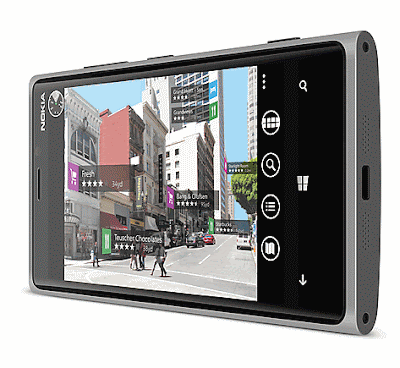The sinking Finnish ship hopes to get a help in the horizon! Nokia, who lost in competition with Apple, Google, and Samsung in the cellphone market, has come up with its latest release—Lumia 920, equipped with Microsoft Windows Phone 8. This makes Lumia 920, the second smartphone to be announced with Windows Phone 8 operating system (the first being Samsung ATIV S). Here’s a first look review of the phone.
The Specifications
| Feature | Value |
|---|---|
| Operating System | Microsoft Windows Phone 8 |
| Display | 4.5 inch, IPS TFT Capacitive Touchscreen, 16.7m colors, 768x1280 px resolution, 326ppi |
| Processor | Qualcomm Snapdragon S4, dual-core 1.5 GHz |
| Body | 130.3X70.8X10.7 mm; 180g |
| Networks | HSPA+, FD-LTE 4G for up to 42 mbps speed |
| Battery | 2000 mAh Li-ion; maximum talktime on 3G: 10 hours, 2G: 17 hours |
| Camera | 8.7 MP autofocus with PurView technology |
| Memory | 1GB RAM, 32GB storage, 7GB in Microsoft SkyDrive |
Hardware Features
1. Display
Lumia 920 was unveiled at a Nokia event in New York yesterday. The specifications of the phone are awesome on any standard. It could well be a great competitor to the other phones in the industry today. The previous version, Lumia 900 had an AMOLED touchscreen, while this one has IPS TFT that comes on iPhone as well. Here’s the difference between AMOLED and IPS TFT. Also, the resolution is big for the display size, making it ultra-clear.
The especial mention is on the pixel per inch ratio of 326, which is awesome. It will look much better than Samsung ATIV S’s display that gives 306 ppi on a 4.8 inch screen. This will make the Lumia display one of the best in the industry today. Although it is smaller than that of HTC One X or Samsung Galaxy S3, the other phones in competition, the size doesn’t matter. You won’t notice a great difference in web browsing and gaming on this device.
2. Memory
An internal storage drive of 32 GB is highly delightful! You can now store anything you want within the phone itself. On the top of that, the phone, being a Windows one, comes with SkyDrive preinstalled. That means, you get 7 GB cloud storage for free (there is also a possibility to get 25 GB from SkyDrive for you). However, the disadvantage in this area is that there is no slot for an external MicroSD card.
3. Design
One of the most innovative sides of Lumia line of smartphones is its awesome design. This phone, however, has no improvement over the previous version. It only looks a slightly bigger version of Lumia 900, with a number of new color options added.
4. Camera
Lumia 920 features an 8.7 MP camera on the rear side that comes with PureView technology. The technology makes the camera lens (Carl Zeiss optic) adjust to the shake in your hand to make the pictures blur-free. Nokia claims the camera has optical image stabilization better than even DSLR cameras. Maybe just a marketing stunt! The camera is said to deliver much brighter images even in low light conditions. This can be confirmed only after actually testing the camera. However, here are a few images that Nokia has uploaded.
5. Other Features
Another caveat on this phone is that it has the Near Field Communication (NFC) technology built in. This will make the smartphone a cool way to pay for products and services.
Conclusion
Based on the features and specifications, Nokia Lumia 920 is great. It may well be a device that will beat the competition in Windows phone market at least. The future will tell.
Update: Full Review of Nokia Lumia 920

